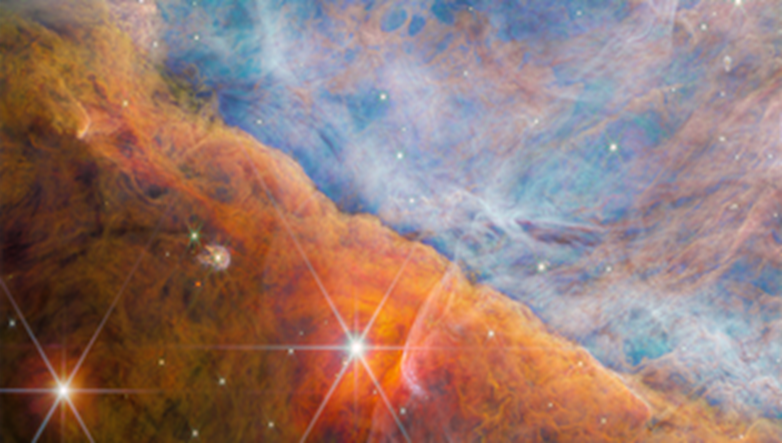For the first time... a research team discovers a new carbon compound that forms the basis of life in space

Part of the Orion Nebula known as the "Orion Bar", a region where active ultraviolet light from the Trapezium Cluster interacts (NASA)
The new carbon compound in space forms the foundations of all known life, and the research team has located this compound in the “Orion Nebula,” which is located in the protoplanetary disk surrounding a young star 1,350 light-years away from Earth.
An international research team was able to discover a carbon compound called dimethyl CH3+ for the first time in space using data collected by the James Webb Space Telescope of NASA, the European Space Agency, and the Canadian Space Agency. The results of the study were published in the journal Nature on June 26.
Maryam Al-Yagouri , the Moroccan researcher involved in the discovery, told Al Jazeera Net via email, “This discovery sheds light on how organic compounds are formed in space and their ability to form life. It also enhances our understanding of the origin of life, and may contribute to the search for extraterrestrial life in particular.”
New carbon compound
This new carbon compound in space forms the foundations of all known life. The research team has located this carbon compound in the “Orion Nebula,” which is located in the protoplanetary disk surrounding a young star 1,350 light-years away from Earth.
According to NASA's press release , scientists have found fingerprints of a molecule in light coming from a rotating planetary disk of dust and gas around a young star. The disk is located in the Orion Nebula, 1,350 light-years from Earth. Note that planetary disks These are the initial stages of forming groups similar to the solar system.
Al-Yaguri says, "This discovery is important because carbon is the basic element in the organic compounds that form the basis of life on Earth. The CH3+ molecule is considered the beginning of chemical reactions and the formation of more complex organic compounds, which means the presence of basic components for life in space. This is a discovery." "It is important for understanding how life emerged on Earth and how it might evolve elsewhere."

The region of the Orion Nebula where the protoplanetary disk D203-506 is located and this is where the CH3+ molecule was discovered (NASA)
Confirmation of scientists' expectations since the 1970s
According to researcher Maryam Al-Yagouri, “This study is of great importance in scientific circles, because it confirms scientists’ expectations since the 1970s regarding the role of the CH3+ molecule in organic chemistry in space. This discovery will contribute to the development of astrochemical models and enhance our understanding of planetary formation processes.” And life in the universe.”
According to the scientific study completed by the research team, it was “suggested that organic chemistry in the gaseous phase in space was initiated by the methyl cation CH3+ 40 years ago, but until now it has not been discovered outside the solar system, and this has now become possible.” Thanks to the data and capabilities of the James Webb Space Telescope.”
Speaking to Al Jazeera Net via email, Maryam noted, "The unexpected nature of the discovery posed a great challenge to the research team."
“When we initially captured the spectrum of the planetary formation disk, we were surprised because we did not know what we were observing,” she says. “To address this, we asked for help from other scientists - particularly spectroscopists who work in laboratory work - to try to reproduce the conditions in space to reproduce molecules.”
James Webb Telescope
According to NASA's press release, "a research team used NASA's James Webb Space Telescope to detect a new carbon compound in space for the first time. It is an important molecule because it helps form carbon molecules."
Carbon compounds form the foundations of all known life, and as such are particularly interesting to scientists working to understand how life evolved on Earth and how it might evolve elsewhere in our universe.

A small area of the Orion Nebula, and in the middle of this view, the team discovered the methyl cation molecule “CH3+” (NASA)
Al-Yagouri explains, “We received preliminary data from the James Webb Telescope within the framework of the international experimental program “PDRs4All-ERS” on Orion’s stripe last September, which means that nearly 10 months passed before we were able to publish This discovery.
She says, "Between analyzing the data, calibrating it, processing it, and then comparing it to laboratory data, it is long-term work that continues over the long term, but in the end there is a return for the efforts expended."
Al-Yaguri added, "The James Webb Telescope helped us in this discovery through its distinctive capabilities in spectroscopic technology. It is a powerful and sensitive space telescope that can detect weak signals in the infrared range from star-forming regions, nebulae, developing planets, and distant galaxies."

She concluded her talk to Al Jazeera Net about the future of research into this discovery by saying, “This scientific discovery requires more in-depth research in the future, because in recent decades it has been considered that the formation of organic molecules in space occurs mainly on the surface of grains, but the discovery of CH3+” “It indicates that there are alternative methods in the gas phase to activate organic chemistry in the presence of ultraviolet radiation, while the detection of CH3+ is a promising achievement, and there are many remaining questions about the catalysis, chemistry, and spectroscopic properties of this molecule.”
Source : websites

